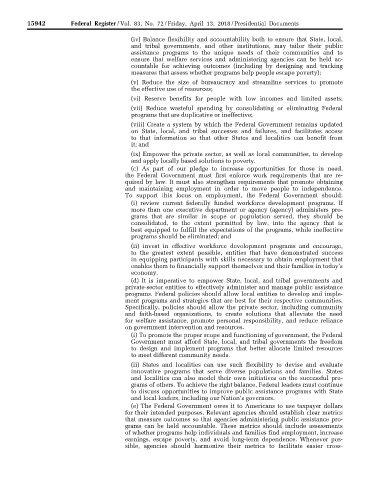Page 658 - Trump Executive Orders 2017-2021
P. 658
15942 Federal Register / Vol. 83, No. 72 / Friday, April 13, 2018 / Presidential Documents
(iv) Balance flexibility and accountability both to ensure that State, local,
and tribal governments, and other institutions, may tailor their public
assistance programs to the unique needs of their communities and to
ensure that welfare services and administering agencies can be held ac-
countable for achieving outcomes (including by designing and tracking
measures that assess whether programs help people escape poverty);
(v) Reduce the size of bureaucracy and streamline services to promote
the effective use of resources;
(vi) Reserve benefits for people with low incomes and limited assets;
(vii) Reduce wasteful spending by consolidating or eliminating Federal
programs that are duplicative or ineffective;
(viii) Create a system by which the Federal Government remains updated
on State, local, and tribal successes and failures, and facilitates access
to that information so that other States and localities can benefit from
it; and
(ix) Empower the private sector, as well as local communities, to develop
and apply locally based solutions to poverty.
(c) As part of our pledge to increase opportunities for those in need,
the Federal Government must first enforce work requirements that are re-
quired by law. It must also strengthen requirements that promote obtaining
and maintaining employment in order to move people to independence.
To support this focus on employment, the Federal Government should:
(i) review current federally funded workforce development programs. If
more than one executive department or agency (agency) administers pro-
grams that are similar in scope or population served, they should be
consolidated, to the extent permitted by law, into the agency that is
best equipped to fulfill the expectations of the programs, while ineffective
programs should be eliminated; and
(ii) invest in effective workforce development programs and encourage,
to the greatest extent possible, entities that have demonstrated success
in equipping participants with skills necessary to obtain employment that
enables them to financially support themselves and their families in today’s
economy.
(d) It is imperative to empower State, local, and tribal governments and
private-sector entities to effectively administer and manage public assistance
programs. Federal policies should allow local entities to develop and imple-
ment programs and strategies that are best for their respective communities.
Specifically, policies should allow the private sector, including community
and faith-based organizations, to create solutions that alleviate the need
for welfare assistance, promote personal responsibility, and reduce reliance
on government intervention and resources.
(i) To promote the proper scope and functioning of government, the Federal
Government must afford State, local, and tribal governments the freedom
to design and implement programs that better allocate limited resources
to meet different community needs.
(ii) States and localities can use such flexibility to devise and evaluate
innovative programs that serve diverse populations and families. States
and localities can also model their own initiatives on the successful pro-
grams of others. To achieve the right balance, Federal leaders must continue
to discuss opportunities to improve public assistance programs with State
and local leaders, including our Nation’s governors.
daltland on DSKBBV9HB2PROD with PRES DOCS 2 VerDate Sep<11>2014 22:09 Apr 11, 2018 Jkt 244001 PO 00000 Frm 00002 Fmt 4790 Sfmt 4790 E:\FR\FM\13APE0.SGM 13APE0
(e) The Federal Government owes it to Americans to use taxpayer dollars
for their intended purposes. Relevant agencies should establish clear metrics
that measure outcomes so that agencies administering public assistance pro-
grams can be held accountable. These metrics should include assessments
of whether programs help individuals and families find employment, increase
earnings, escape poverty, and avoid long-term dependence. Whenever pos-
sible, agencies should harmonize their metrics to facilitate easier cross-

